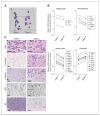Functional gene expression analysis uncovers phenotypic switch in aggressive uveal melanomas
- PMID: 16651410
- PMCID: PMC5407689
- DOI: 10.1158/0008-5472.CAN-05-4196
Functional gene expression analysis uncovers phenotypic switch in aggressive uveal melanomas
Abstract
Microarray gene expression profiling is a powerful tool for generating molecular cancer classifications. However, elucidating biological insights from these large data sets has been challenging. Previously, we identified a gene expression-based classification of primary uveal melanomas that accurately predicts metastatic death. Class 1 tumors have a low risk and class 2 tumors a high risk for metastatic death. Here, we used genes that discriminate these tumor classes to identify biological correlates of the aggressive class 2 signature. A search for Gene Ontology categories enriched in our class-discriminating gene list revealed a global down-regulation of neural crest and melanocyte-specific genes and an up-regulation of epithelial genes in class 2 tumors. Correspondingly, class 2 tumors exhibited epithelial features, such as polygonal cell morphology, up-regulation of the epithelial adhesion molecule E-cadherin, colocalization of E-cadherin and beta-catenin to the plasma membrane, and formation of cell-cell adhesions and acinar structures. One of our top class-discriminating genes was the helix-loop-helix inhibitor ID2, which was strongly down-regulated in class 2 tumors. The class 2 phenotype could be recapitulated by eliminating Id2 in cultured class 1 human uveal melanoma cells and in a mouse ocular melanoma model. Id2 seemed to suppress the epithelial-like class 2 phenotype by inhibiting an activator of the E-cadherin promoter. Consequently, Id2 loss triggered up-regulation of E-cadherin, which in turn promoted anchorage-independent cell growth, a likely antecedent to metastasis. These findings reveal new roles for Id2 and E-cadherin in uveal melanoma progression, and they identify potential targets for therapeutic intervention.
Figures





References
-
- Harbour JW. Clinical overview of uveal melanoma: introduction to tumors of the eye. In: Albert DM, Polans A, editors. Ocular oncology. New York: Marcel Dekker; 2003. pp. 1–18.
-
- Eskelin S, Pyrhonen S, Summanen P, Hahka-Kemppinen M, Kivela T. Tumor doubling times in metastatic malignant melanoma of the uvea: tumor progression before and after treatment. Ophthalmology. 2000;107:1443–9. - PubMed
-
- Callender GR. Malignant melanotic tumors of the eye: a study of histologic types in 111 cases. Trans Am Acad Ophthalmol Otolaryngol. 1931;36:131–42.
-
- Folberg R, Pe'er J, Gruman LM, et al. The morphologic characteristics of tumor blood vessels as a marker of tumor progression in primary human uveal melanoma: a matched case-control study. Hum Pathol. 1992;23:1298–305. - PubMed
-
- Gamel JW, McLean IW. Quantitative analysis of the Callender classification of uveal melanoma cells. Arch Ophthalmol. 1977;95:686–91. - PubMed
Publication types
MeSH terms
Substances
Grants and funding
LinkOut - more resources
Full Text Sources
Other Literature Sources
Medical

